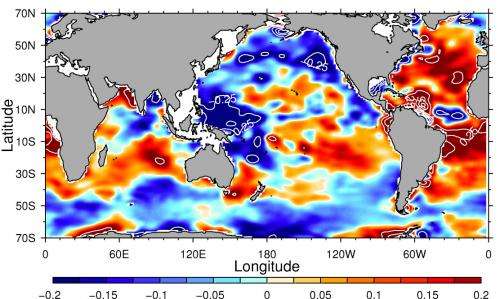Atmospheric warming altering ocean salinity

The warming climate is altering the saltiness of the world's oceans, and the computer models scientists have been using to measure the effects are underestimating changes to the global water cycle, a group of Australian scientists have found.
The water cycle is the worldwide phenomenon of rainwater falling to the surface, evaporating back into the air and falling again as rain.
The wetter parts of the world are getting wetter and the drier parts drier. The researchers know this because the saltier parts of the ocean are getting saltier and the fresher parts, fresher.
Records showed that the saltier parts of the ocean increased salinity -- or their salt content -- by 4 percent in the 50 years between 1950 and 2000. If the climate warms by an additional 2 or 3 degrees, the researchers project that the water cycle will turn over more quickly, intensifying by almost 25 percent.
Reporting in Science magazine, the researchers said the results of the change in climate would affect agriculture and the ability of drier areas to capture and use fresh water from rain, creating serious problems, including droughts and floods. But they had to look offshore to find their data.
"The oceans are really where the action is happening," said Paul Durack, the lead author.
The study uses 50 years of data -- from 1950-2000 -- gathered by instruments, some adrift on the ocean currents, some tethered in place. Some of the instruments are tiers of bottles that open at various depths as they are lowered into the sea, and they take measurements as far down as 9,000 feet.
Durack, who received his Ph.D. from the University of Tasmania, and is now in a post-doctoral fellowship at Lawrence Livermore Laboratory in California, said that "salinity shifts in the ocean confirm climate and the global water cycle have changed."
The oceans cover 71 percent of the Earth's surface. They contain 97 percent of the world's water; receive 80 percent of the rainfall, and have absorbed 90 percent of the energy produced by global warming.
The relationship between salinity in the sea and the water cycle is well documented, the scientists wrote. Changes in salinity could also affect water currents because saltwater is denser than fresh water and sinks.
Warmer air can absorb more water than cooler air, so as the climate warms, more water can evaporate into the air. The amount evaporated increases 7 percent for every degree Celsius the temperature increases, the scientists reported.
That intensifies the water cycle on both ends of the spectrum. In places where rainfall exceeds evaporation, the rain is increasing; in the places where evaporation rates are higher than rainfall, it gets drier.
Some of the change is directly caused by warmer temperatures. For instance, the ocean waters around Antarctica are getting less salty because the waters are being refreshed by the melting ice cap.
Arid areas that require rainfall to provide water for irrigation, for drinking and industry, will see less rainfall, he said. That is a more significant threat than just an increase in temperature.
"Changes in the global water cycle and the corresponding redistribution of rainfall will affect food availability, stability, access, and utilization," Durack said. "I come from Perth, in dry western Australia, and you can see the change."
Most computer models depend on land-based observation, which accounts for the difference, but Durack and his collaborators, Susan E. Wijffels and Richard J. Matea, think measuring the oceans gives a more accurate picture, what they called an "identifiable fingerprint." Their work covers 71 percent of the world's water cycle.
"The most important part of the research is the basic observation that the 50-year trend in salinization is indeed that the fresh water is getting fresher and the saltwater saltier," said Dean Roemmich, a professor of oceanography at the Scripps Institution of Oceanography. "It is a fundamental change."
More information: Ocean Salinities Reveal Strong Global Water Cycle Intensification During 1950 to 2000, Science 27 April 2012: Vol. 336 no. 6080 pp. 455-458. DOI: 10.1126/science.1212222
ABSTRACT
Fundamental thermodynamics and climate models suggest that dry regions will become drier and wet regions will become wetter in response to warming. Efforts to detect this long-term response in sparse surface observations of rainfall and evaporation remain ambiguous. We show that ocean salinity patterns express an identifiable fingerprint of an intensifying water cycle. Our 50-year observed global surface salinity changes, combined with changes from global climate models, present robust evidence of an intensified global water cycle at a rate of 8 ± 5% per degree of surface warming. This rate is double the response projected by current-generation climate models and suggests that a substantial (16 to 24%) intensification of the global water cycle will occur in a future 2° to 3° warmer world.
Journal information: Science
Provided by Inside Science News Service



















